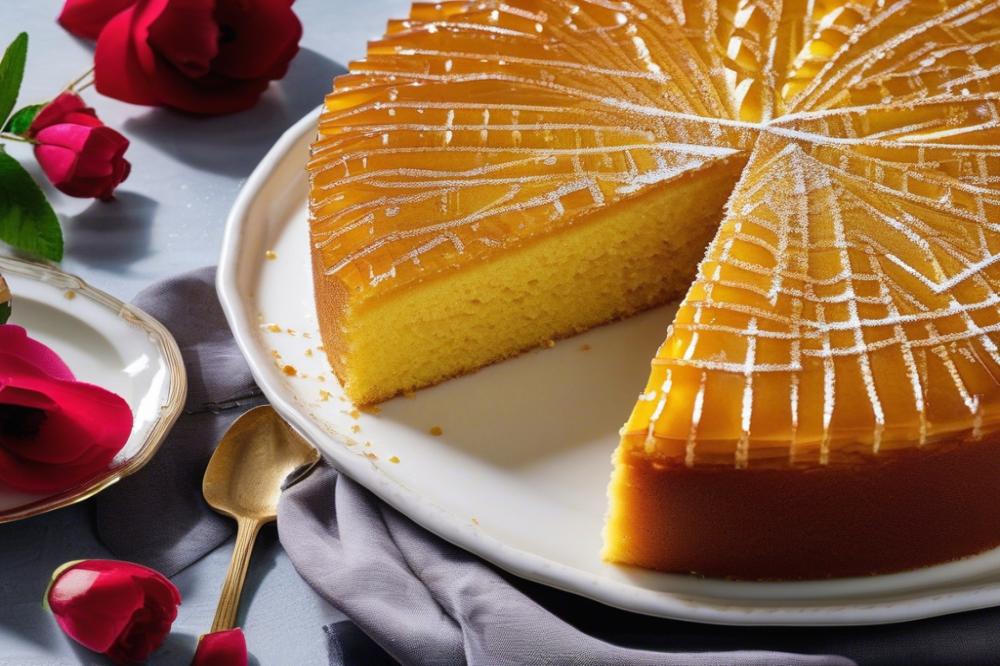Introduction
Pantespani is a cherished staple in the realm of traditional Greek desserts. This sponge cake holds a special place in the hearts of many. It embodies family gatherings, festive occasions, and simple moments of joy. Across Greece, sponge cake plays an essential role in various sweet treats. It is loved for its light texture and adaptability in numerous recipes.
Creating this iconic cake involves using simple yet quality ingredients. The key components are a fluffy cake and a rich syrup that adds flavor and sweetness. This cake syrup complements the airy consistency beautifully. Many people appreciate how easy recipes can turn an ordinary day into a delightful experience.
In the following sections, readers will find a comprehensive guide to this Greek sponge cake recipe. With attention to detail, baking enthusiasts can recreate this delightful treat at home. Join us as we explore the techniques and secrets to making Pantespani a part of your dessert repertoire.
Understanding Pantespani

Pantespani is a beloved sponge cake that holds a special place in Greek culture. This dessert is known for its light, airy texture and sweet flavor. Traditional Greek dessert recipes often feature it at celebrations and gatherings. The fluffy cake becomes even more delightful when soaked in cake syrup, making each bite a sweet treat.
Comparing Pantespani to other Greek recipes can help highlight its significance. While baklava is rich and nutty, and galaktoboureko is creamy, Pantespani offers a softer profile. Its simplicity is part of its charm. Many families treasure this recipe, passing it down through generations.
Historically, sponge cakes have a long tradition in various cultures. In Greece, baking techniques evolved over centuries. Many regions have their versions of this cake. Some might add citrus for a zesty flair, while others incorporate spices. Each variation brings its unique taste, showcasing regional ingredients and local customs.
The versatility of Pantespani allows for many interpretations. Families might serve it plain or topped with fruits or cream. When drizzled with syrup, this easy recipe transforms the cake into a decadent dessert. Each slice tells a story of family gatherings and festive occasions.
Ingredients and Measurements

Creating a fluffy cake starts with gathering the right ingredients. For this Greek sponge cake recipe, you’ll need the following:
- 4 large eggs
- 1 cup of sugar
- 1 cup of all-purpose flour
- 1 teaspoon of baking powder
- 1 teaspoon of vanilla extract
- 1/4 cup of olive oil or melted butter
- 1/2 cup of water
- 1 tablespoon of lemon juice
These basic ingredients come together to form the delightful base of the dessert. Just as important is the syrup that enhances the sweet treats. Here’s what you need for that:
- 1 cup of sugar
- 1 cup of water
- Zest from 1 lemon
Nutritional Information
Understanding the caloric values and macronutrient breakdown can help you enjoy this traditional Greek dessert with awareness. Below is a general overview for each ingredient:
- Eggs (4 large): Approximately 280 calories, 24g protein, 20g fat.
- Sugar (2 cups total): About 1,440 calories, 0g protein, 0g fat.
- Flour (1 cup): Roughly 455 calories, 13g protein, 1g fat.
- Baking powder (1 tsp): Negligible calories, 0g protein, 0g fat.
- Vanilla extract (1 tsp): About 12 calories, 0g protein, 0g fat.
- Olive oil or butter (1/4 cup): Around 450 calories, 0g protein, 51g fat (for butter).
- Water (1/2 cup): 0 calories.
- Lemon juice (1 tbsp): Approximately 4 calories.
- Syrup (1 cup sugar, 1 cup water, zest from one lemon): About 1,440 calories from sugar.
The total caloric content can be substantial, especially with the syrup. Keep this in mind while enjoying the delicious Greek recipes that include delightful elements of taste and satisfaction.
Cooking Instructions

Preparing the Cake Batter
Begin by gathering your ingredients. You’ll need eggs, sugar, flour, and baking powder. In a large mixing bowl, whisk together the eggs and sugar until the mixture becomes light and fluffy. This process might take several minutes, so be patient. Next, sift in the flour and baking powder. Gently fold the dry ingredients into the egg mixture. This step is crucial for maintaining the airiness of the batter. Be careful not to overmix, as that can ruin the texture.
Baking
Preheat the oven to 350°F (175°C). Grease and flour a round cake pan before pouring in the batter. Bake the cake for approximately 30 to 35 minutes. Look for a golden top and springy texture. To check doneness, insert a toothpick into the center. If it comes out clean, your cake is ready. If not, give it a few more minutes.
Cooling Process
After baking, remove the cake from the oven and let it cool in the pan for about 10 minutes. Then, transfer it to a wire rack. Complete cooling should take around 30 minutes. This step is important because a hot cake can become soggy. Allowing it to cool properly creates a fluffy cake that is perfect for syrup infusion.
Preparing the Syrup
While the cake cools, start making the syrup. Combine equal parts water and sugar in a small saucepan. For some added flavor, you might consider including a slice of lemon or a stick of cinnamon. Bring the mixture to a gentle boil. Then, reduce the heat and let it simmer for about 10 minutes. The syrup should become slightly thickened. Afterward, remove it from the heat and let it cool.
Infusing the Syrup into the Cake
Once both the cake and syrup are cool, it’s time for the best part. With a skewer or toothpick, poke holes all over the top of the sponge. This allows the syrup to soak in well. Slowly drizzle the cooled syrup over the cake, allowing it to absorb the sweet liquid. Use as much or as little syrup as you desire to achieve the right level of sweetness for your taste.
Serving and Presentation
To serve this traditional Greek dessert, consider cutting the cake into neat slices. Placing each piece on a decorative plate adds an elegant touch. For a finishing touch, sprinkle powdered sugar on top or garnish with fresh fruit. These sweet treats will impress family and friends. When presenting, it’s nice to share the story of how this unique sponge cake recipe is a staple in Greek culture.
Variations and Serving Suggestions

Exploring adaptations of the classic sponge cake recipe opens up a world of possibilities. You can easily add flavor profiles by introducing ingredients like lemon zest or orange juice to the batter. These additions will brighten the cake, creating a refreshing twist. For those who enjoy more texture, consider folding in chopped nuts such as almonds or walnuts. This creates a delightful crunch that complements the fluffy cake.
Another variation involves spices. A dash of cinnamon or a hint of vanilla can enhance the overall taste. Some cooks even experiment with cardamom for a more exotic flavor. These spices can transform the dessert into something truly special.
Serving Suggestions
When it comes to serving, think about pairing the cake with whipped cream. The lightness of the cream provides balance to the sweetness of the syrup. Fresh fruit also makes an excellent accompaniment. Strawberries, raspberries, or even a fruit compote can add a burst of flavor and color to the plate.
Serving the cake on its own allows its simplicity to shine. This traditional Greek dessert can stand proudly by itself, especially when drizzled with the delicious cake syrup. Presentation can elevate your dessert experience. Consider dusting the top with powdered sugar for a lovely finish. Using a cake stand can add elegance when serving at gatherings or special occasions.
For festive events, layer slices with fresh fruit and whipped cream to create an eye-catching dessert display. Use colorful plates or garnishes to draw attention to this delightful treat. Whether it’s for a birthday or a family gathering, these enhancements will impress your guests.
Nutritional Analysis and Health Considerations
Pantespani is a delightful dessert that showcases the heart of traditional Greek recipes. Each ingredient contributes its own nutritional profile. For instance, eggs provide high-quality protein and essential vitamins like B12 and D. They help in muscle repair and maintaining healthy skin.
The flour used in baking can make a difference. Many recipes call for all-purpose flour, which lacks fiber. Whole grain flour, on the other hand, boasts higher fiber content, making it a better option for those seeking health benefits. Fiber aids in digestion and can promote a feeling of fullness.
Reducing sugar is another way to make this fluffy cake healthier. Sometimes, cutting back on sweetness can maintain the cake’s deliciousness without overwhelming taste buds. Alternatives like honey or maple syrup can also add flavor while providing some nutrients.
The syrup used on top enhances the dessert’s sweetness. However, it can significantly increase calorie intake. Instead of a syrupy soak, consider savoring the cake with fresh fruit or a light sprinkle of powdered sugar for more natural sweetness.
In the context of a balanced diet, this sponge cake recipe can fit in on special occasions. Moderation is key with any sweet treats. Serving size matters. Enjoy a small slice while balancing meals with fruits, vegetables, and proteins throughout the day.
Thinking about healthier variations opens up many possibilities. Simply swapping out some ingredients can transform this traditional Greek dessert into a treat that aligns more closely with health goals. By making small adjustments, baking can be both enjoyable and nutritious.
Final Thoughts on Baking Greek Sponge Cake
In summary, preparing this delightful Greek dessert is an enjoyable experience that combines simple ingredients with traditional techniques. Begin by creating a light and airy sponge, which serves as the heart of the cake. After baking, drench it in a fragrant syrup, and watch as it transforms into something truly special.
Feel free to experiment with variations. Different flavors, such as lemon or orange zest, can brighten up the cake. Adding a splash of your favorite liqueur to the syrup can elevate the taste. Customizing recipes not only makes the experience more personal but also leads to unexpected culinary delights.
Baking traditional treats brings lasting joy, especially when shared. Invite family and friends to join in the creation. The act of offering homemade sweets can foster connections, creating memories that will be cherished.
In the end, let your creativity shine as you embark on this baking adventure. Embrace the process, and enjoy sharing a slice of culture through every bite.



